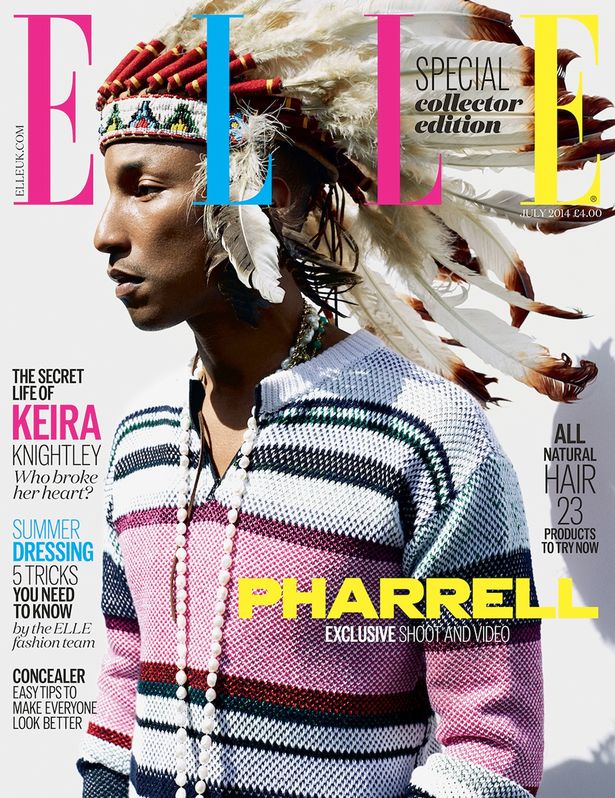
Since moving from New York City to London six months ago, I’ve realized that fashion on this side of the pond is a different beast. On the street, there’s a more natural, less labored personal style—utilitarianism rules, and that American fondness for flash is nearly invisible. On the other hand, fashion is culturally held in much higher regard here; Dior, McQueen and Ghesquière score mention in the same conversation as Koons, Picasso or Michelangelo. Families with no ties to the fashion industry are just as likely to take in the Isabella Blow or Jean-Paul Gaultier exhibits as they might the new Matisse, all of which are given equally prominent advertising in subway stations, and critical attention in the arts sections of newspapers. And yet, for all the seeming cultural awareness, incidents like this latest one involving ELLE UK, Pharrell, and a Native American headdress seem to happen far more frequently in European publications than in American ones.
Only halfway over, 2014 has already been a banner year for European fashion editors’ bad judgment. In January, Dasha Zhukova, founder and editor of Garage (based in London) was featured in the magazine Buro 24/7 (an online Russian fashion publication) sitting on topless black mannequin so lifelike that upon looking at the image, it’s almost impossible to tell that the Bjarne Melgaard-designed “chair” isn’t a black model conforming to the pretty white lady’s tush. Buro’s editor was quick to issue an apology, explaining that Melgaard’s work was a “commentary on racial politics.” That the editorial had been released on Martin Luther King, Jr., Day hardly matters—King was American, so it’s not a memorial holiday over here. But that is part of the problem; if a society doesn’t take note of its mistakes, its horrors, it’s all too easy to forget how wrong things can go.
A couple of months after the Buro debacle,Vogue Italia, which has a long and complicated relationship with race, published “Abracadabra,”a multi-page fashion story featuring white model Saskia De Brauw in tribal paint, posing semi-nude, gape-mouthed with safari animals. Not surprisingly, the feature did not go over well internationally. When interviewed by The Cut about Vogue Italia’s repeat bouts of racism, longtime editor in chief Franca Sozzani was far from apologetic: “You can just take pictures like in a catalog so you will never be controversial, but that’s not my choice of life.”
Misguided as Sozzani may have been, at mainstream American fashion magazines, photo shoots are rarely if ever used as commentary on a serious subject like race or misogyny or religion. And there are plenty of reasons why. First, magazines live and die by advertising pages; the more advertisers you have, the more editorial content you can include. Today, advertising in print is a hard sell, so once you’ve clinched that deal editors, why do anything to jeopardize the relationship? In Europe, the major fashion magazines function more or less as art books, and are supported and embraced by an art-hungry culture. Second, the American fashion magazine audience primarily reads for aspirational fantasy and commerce. Does that mean the former is more willing to take a risk making a statement—the risk occasionally resulting in disaster? Maybe. A generalization to be sure, but having lived in both cultures and witnessed a marked difference between the content, I think it stands.
The Pharrell incident, in the grand scheme of fashion offenses, seems more a case of irresponsible styling than a political statement gone wrong. Karl Lagerfeld came under similar fire for placing headdresses on models at his Chanel metiers d’arts show in Dallas this spring. Again, Europeans do not have an intimate understanding of the atrocities committed against Native Americans. But the lesson learned is clear: next time, just don’t.
Johanna Cox is a writer living in London.
More Must-Reads from TIME
- Donald Trump Is TIME's 2024 Person of the Year
- Why We Chose Trump as Person of the Year
- Is Intermittent Fasting Good or Bad for You?
- The 100 Must-Read Books of 2024
- The 20 Best Christmas TV Episodes
- Column: If Optimism Feels Ridiculous Now, Try Hope
- The Future of Climate Action Is Trade Policy
- Merle Bombardieri Is Helping People Make the Baby Decision
Contact us at letters@time.com